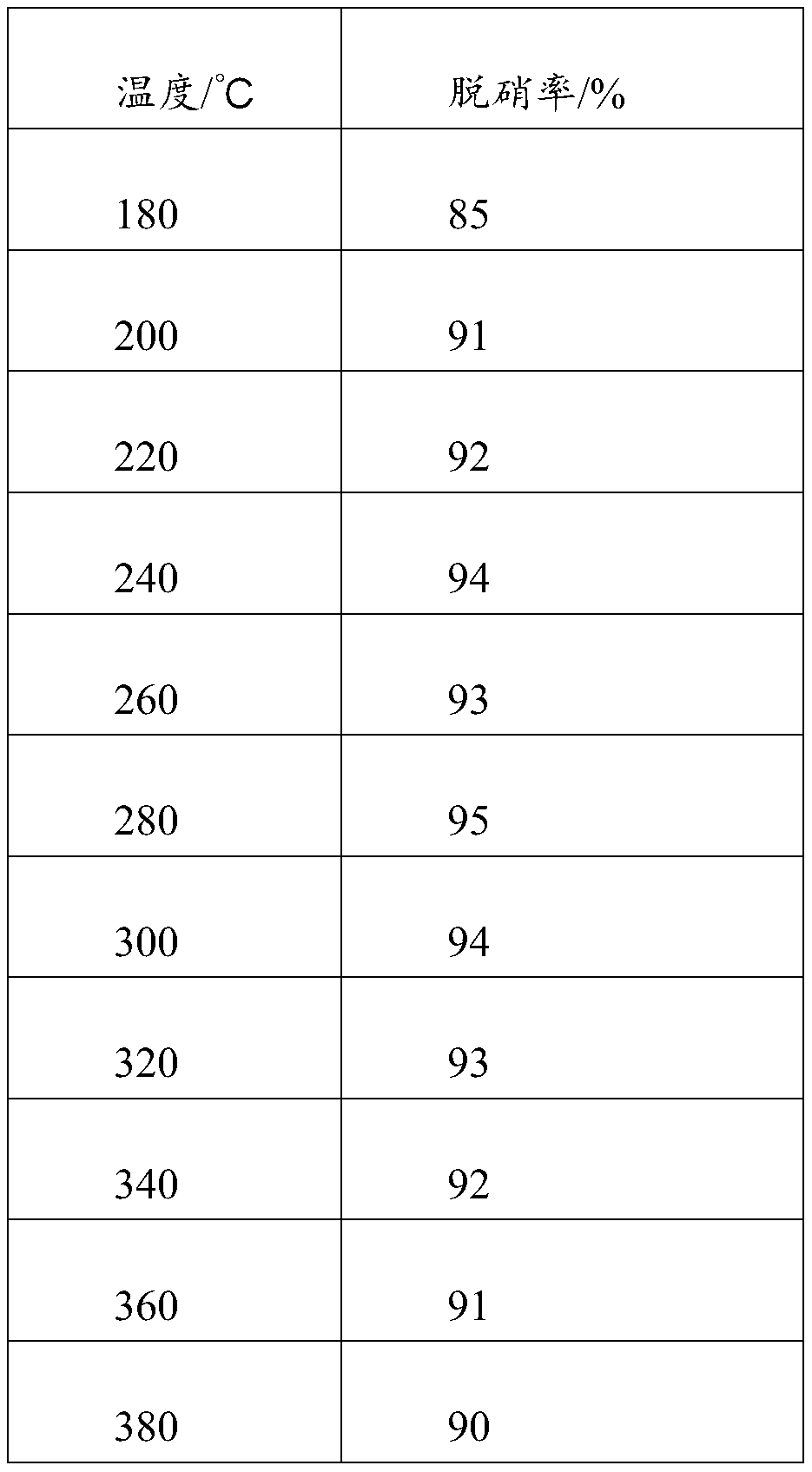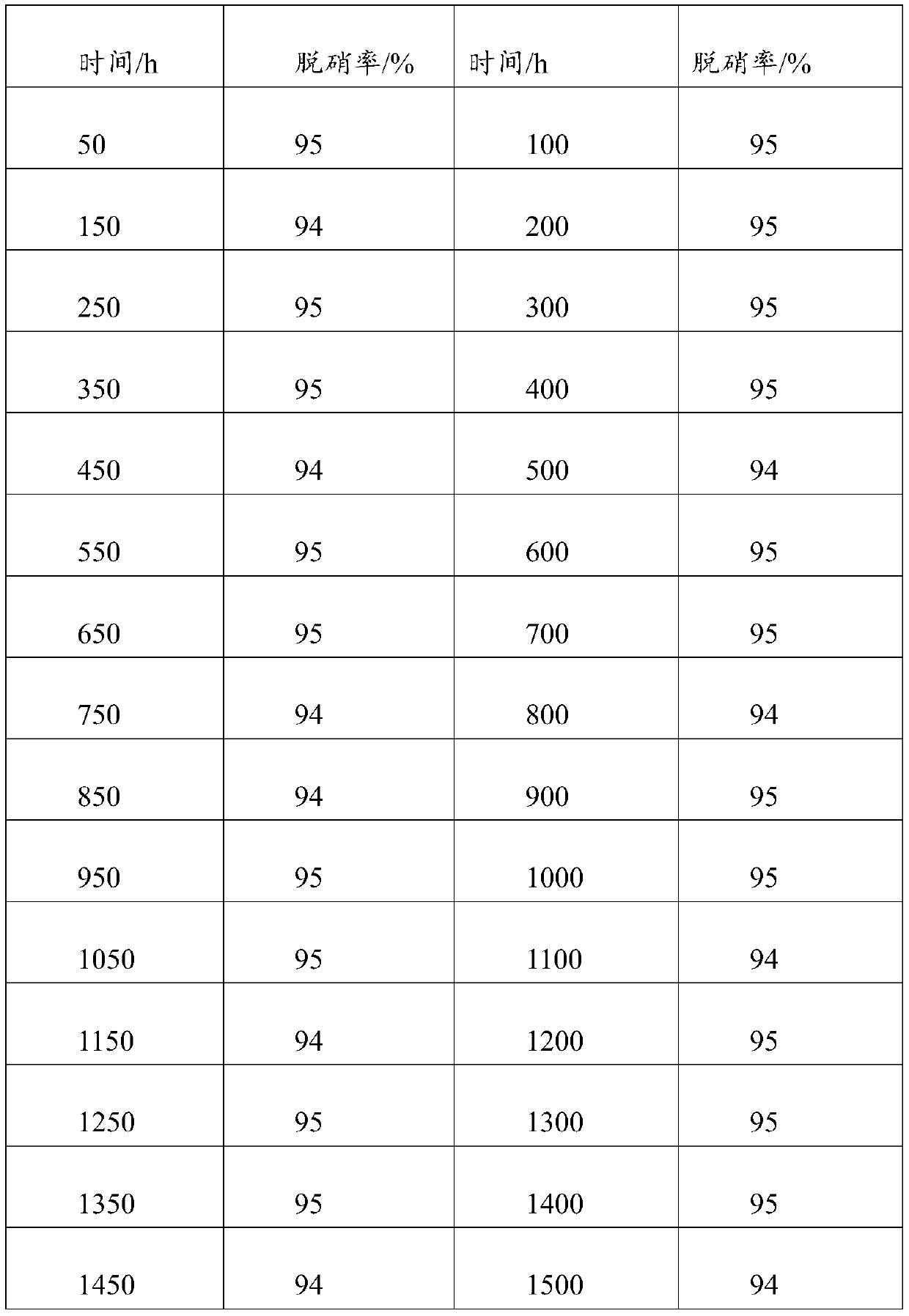Honeycomb type low-temperature denitrification catalyst and preparation method thereof
A low-temperature denitration and catalyst technology, which is applied in chemical instruments and methods, physical/chemical process catalysts, separation methods, etc., can solve the problems of unsatisfactory catalytic activity, insufficient service life, and decreased catalyst activity, so as to improve the anti-SO2 ability. , reduce the dosage, the effect of uniform distribution
- Summary
- Abstract
- Description
- Claims
- Application Information
AI Technical Summary
Problems solved by technology
Method used
Image
Examples
Embodiment 1
[0034] A method for preparing a honeycomb low-temperature denitration catalyst, comprising the steps of:
[0035] 1) Treatment of carbon nanotubes: Weigh 100g of single-walled carbon nanotubes with a diameter of 20-40nm and a length of 1-2μm purchased by Shenzhen Nanoport Co., Ltd., add 500ml of 3mol / L permanganate to it, and heat to 120°C Under reflux for 8 hours, cooled to room temperature, centrifuged, washed with clear water until neutral, to obtain acidified carbon nanotubes; adding 50 g of acidified carbon nanotubes to 500 ml of sodium lignosulfonate aqueous solution with a concentration of 10 g / L, first Place it in a 20Hz sonicator for 1 hour, and then place it in a 50°C water bath for 10 hours under stirring conditions. After the reaction, centrifuge to remove unreacted sodium lignosulfonate, and obtain carbon nanotubes with negative charges on the surface;
[0036] 2) Preparation of LDHs: Using manganese nitrate, copper nitrate and aluminum nitrate as raw materials, a...
Embodiment 2
[0041] A method for preparing a honeycomb low-temperature denitration catalyst, comprising the steps of:
[0042] 1) Treatment of carbon nanotubes: Weigh 100g of multi-walled carbon nanotubes with a diameter of 20-40nm and a length of 1-2μm purchased by Shenzhen Nanoport Co., Ltd., add 500ml of 3mol / L nitric acid to it, and heat to 130°C for reflux After 5 hours, cool down to room temperature, centrifuge, wash with water until neutral to obtain acidified carbon nanotubes; weigh 50 g of acidified carbon nanotubes and add to 500 ml of polystyrene sodium sulfonate (PSS for short) with a concentration of 6 g / L In the aqueous solution, first place it in a 20Hz sonicator for 2 hours, and then place it in a water bath at 60°C under stirring conditions for 7 hours. After the reaction, centrifuge to remove unreacted PSS, and obtain carbon nanotubes with negative charges on the surface;
[0043] 2) Preparation of LDHs: Using water-soluble manganese chloride, copper chloride and aluminum...
Embodiment 3
[0048] A method for preparing a honeycomb low-temperature denitration catalyst, comprising the steps of:
[0049] 1) Treatment of carbon nanotubes: Weigh 100g of multi-walled carbon nanotubes with a diameter of 20-40nm and a length of 1-2μm purchased by Shenzhen Nanoport Co., Ltd., add 500ml of 5mol / L sulfuric acid to it, heat to 140°C and reflux After 3 hours, cool down to room temperature, centrifuge, wash with water until neutral to obtain acidified carbon nanotubes; weigh 50 g of the obtained acidified carbon nanotubes and add to 500 ml of sodium dodecylbenzenesulfonate with a concentration of 1 g / L In the aqueous solution, first place it in a 20Hz sonicator for 1 hour, and then place it in a 70°C water bath for 4 hours under stirring conditions. After the reaction, centrifuge to remove unreacted sodium dodecylbenzenesulfonate, and obtain negatively charged carbon nanotubes;
[0050] 2) Preparation of LDHs: Using manganese sulfate, copper sulfate and aluminum sulfate as r...
PUM
 Login to View More
Login to View More Abstract
Description
Claims
Application Information
 Login to View More
Login to View More - R&D
- Intellectual Property
- Life Sciences
- Materials
- Tech Scout
- Unparalleled Data Quality
- Higher Quality Content
- 60% Fewer Hallucinations
Browse by: Latest US Patents, China's latest patents, Technical Efficacy Thesaurus, Application Domain, Technology Topic, Popular Technical Reports.
© 2025 PatSnap. All rights reserved.Legal|Privacy policy|Modern Slavery Act Transparency Statement|Sitemap|About US| Contact US: help@patsnap.com



